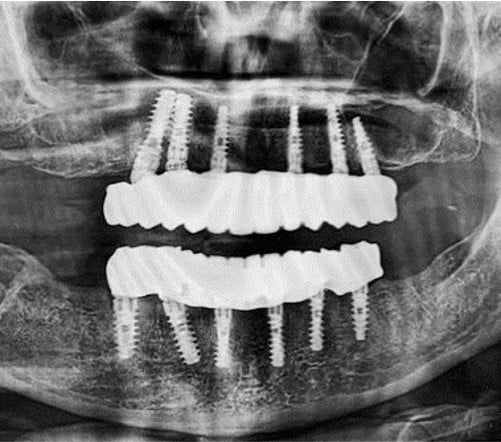Dual AO6 with subsequent replacement of prosthesis to zirconia 7 years post op
Dr. G. Rafalovitz
Main complaint
In 2013 patient complained of discomfort due to full upper and partial lower removable dentures. patients asked for a fixed restoration.
Medical history
- Female, was 67 years old in 2013.
- Generally healthy, allergic to Resprim (sulpha).
Case description
- In 2013, 3 remaining teeth in the lower jaw were extracted and dual, upper and lower AO6 were performed.
- It was immediately temporarily loaded within 24 hours.
- 4 months later, once all implants were osseointegrated and soft tissue stabled, restoration was replaced by definite restoration.
- The restoration was a screw-retained hybrid prosthesis (i.e. made of composite and acrylic reinforced with a cast metal framework).
- Periodic checkups showed stable bone level.
- The patient reported great satisfaction both with function and esthetics.
- In 2020, after 7 years of function, the hybrid prosthesis showed wear and tear, such as some erosion and slight discoloration.
- It was decided to replace the prosthesis with a new monolithic screw-retained zirconia restoration.
- Upper jaw implants were scanned against the old lower restoration and a new upper restoration was created. Once the upper restoration was put in place, lower implants were scanned against it and a new lower restoration was created.
- The end result was a new set of upper and lower screw-retained monolithic zirconia restoration. Digital workflow allowed for accurate, esthetic and quick results.
Products & materials used:
12 AB Dental devices i5 implants were used right to left:
Upper 4.2/16, 4.2/13, 4.2/13, 4.2/13, 4.2/13, 4.2/11.5
Lower 4.2/11.5, 4.2/13, 4/2/13, 4.2/14, 4/2/13, 4.2/11.5
In 2013, 4 upper mesial implants (14,12,22,24) were fitted with P14 multi-units and the rest of the implants with P12 flat connection abutments.
- In 2020 the P12 in the upper distal implants (16,26) were replaced with a P64 multi-unit.
Scan posts: regular implant-level scan posts were used with all lower implants.
P14 scan posts were used with the 4 upper mesial implants (14,12,22,24) and a P64 scan post with the upper distal implant (16,26).
Appropriate Ti-bases were used.
Dental lab:
Mr. Shimon Soval
Smile tec dental lab














